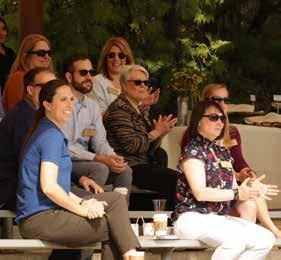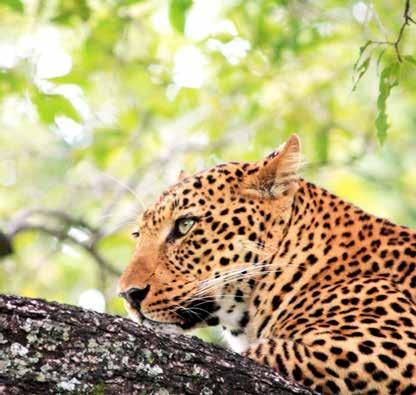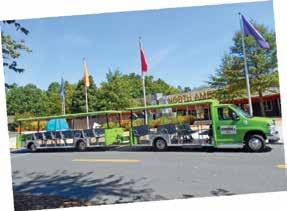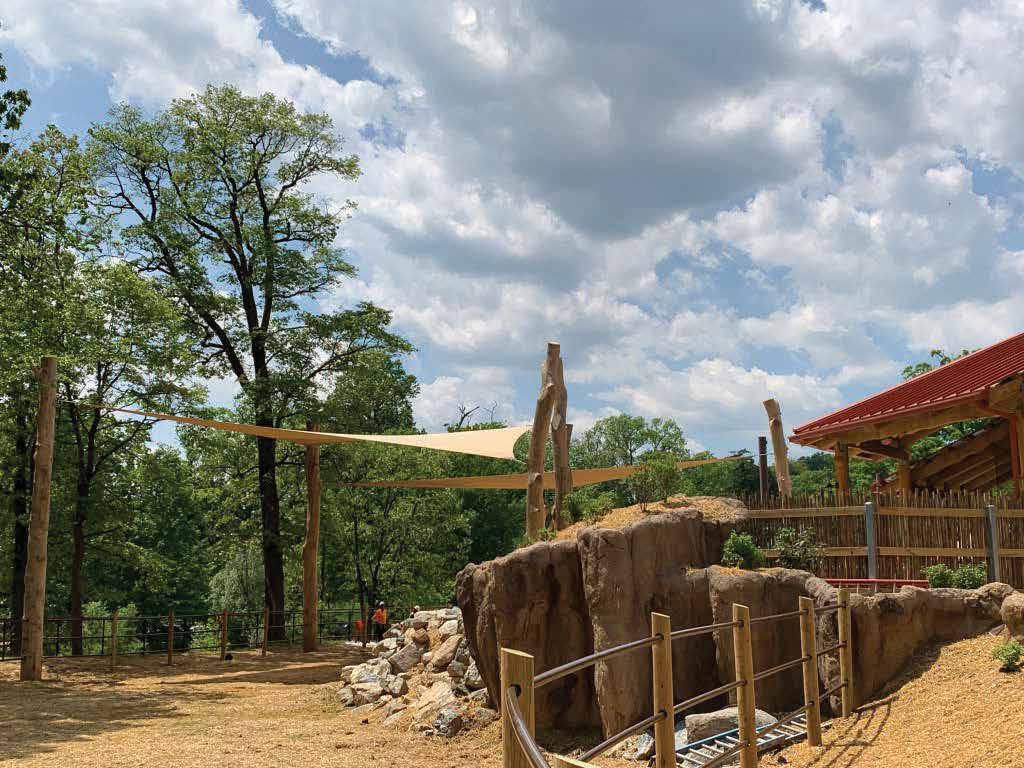

A wise older fish swims by two younger fish and says, “Hey, how’s the water?” Soon after, the younger fish asked the other, “What is water?”
This short parable from David Henry Wallace demonstrates what all communities and organizations struggle with. It’s difficult to recognize or understand the culture we live in when we are in the middle of it. How do we create, design, discuss, and begin to make changes to our environment without someone opening our eyes to see it?
The ECHO initiative, facilitated by GLMV Zoos, invites brilliant thinkers, curious creators, and those outside the "water" to come together to help each other see our world differently.
Each year nearly 40 creative and thoughtful leaders from across North America come together for this intense two and a half day thought-partnering workshop. We listen to people present compelling ideas, we ask deeper questions, and we engage in dialogs that will ultimately strengthen our community.
In 2019, ECHO was hosted by The Living Desert in Palm Desert, California and focused on “The Leadership Gap: Understanding our Culture and Building Organizations that can take on the Challenges of the Future.”
These session recaps and photos capture some of this year’s highlights. But the only way to really appreciate the experience is to join us at next year’s ECHO workshop in May 2020 at Birmingham, Alabama.

ECHO creates collisions of thought to cultivate a more inspirational and innovative future for zoos and aquariums
1





2
At-a-Glance
DAY 1 • MAY 21 DAY 2 • MAY 22
Welcome Reception
ECHO19 kicks off!
Special thanks to The Living Desert for their gracious hospitality.


The 5-Generation Workforce
Dr. Wendi Dykes & Dr. Jillian Gilbert
Serious Play + Creative Confidence
Dr. Wendi Dykes & Dr. Jillian Gilbert
DAY 3 • MAY 23

The Art of Relevance
Nina Simon
Paradigm Shifts: Redefining Exhibits
GLMV Zoos
Honest Leadership
Nina Simon
Integration Tactics
Zoo Advisors
3
The 5-Generation Workforce
DR. WENDI DYKES AND DR. JILLIAN GILBERT
Did you know that the Traditionalist generation owns 75 percent of the nation's wealth? By 2025, more than three-quarters of the entire workforce will be Millennials.

This is the first time in history that five generations are all working side by side.
Dr. Wendi Dykes and Dr. Jillian Gilbert presented an interactive session focused on understanding and maximizing people's talents from all generations in our workforce. There have always been multigenerational workforces, but the differences between these groups seem greater than ever.
Most of us are familiar with the descriptions of Generations categories. Jill and Wendi guided the group through different approaches when working with multi-generations that make the most impact on your organizations. Participants defined formative experiences for each generation, which help define how they approach work and interactions. The group explored how generations view authority, their role in the workforce, and how they relate to others.

4
The Generations
Being aware of differences is important, and learning to work together requires finding commonalities.
Although birth year is commonly used to define generations, it's more complex than that. The categories also need to include where people are born, where parents fit into the Generation Chart, what parenting style they adopted, and individual experiences. Participants were directed to rewrite, mix and match, and explore and understand themselves within a larger framework.
The biggest discussion among ECHO Participants was about work ethic. A few Boomers said, “The problem is that Millennials don’t have any work ethic.” Jill and Wendi asked for a work-ethic definition. Boomers defined it as arriving to work on time, working the entire shift, completing tasks, and leaving at a defined time. Millennials defined work ethics by how much they contributed to projects, and place emphasis on mental and creative contributions. They are less focused on arrival and departure times, but
rather focus on collaborative contributions. Millennials aren’t hesitant to work odd hours, stay late, or work on weekends as long as they are positively contributing to projects. But there lies the key. Are we slowing down to understand one another? For example, if a Boomer tells a Millennial they don’t have any work ethics then a wall goes up ending a conversation before it even begins. This approach does not get anyone meaningful results.
Gen X-ers, commonly overlooked and often misunderstood, are viewed as difficult or unwilling to work with. This, in turn, does not allow X-ers to contribute to their full potential. As a generation, X-ers are one of the most productive groups and creative problem solvers. As the Latch-Key Kid Generation, they can take a big-picture task that has little to no details, and they can add definition and get it done.
These roles can be compared to Gen Z, where their social online networks are actually a part of their character. Gen Z needs to have their emotional state recognized before they deem you safe to work with. But once this is defined, Gen Z are quick to show how much they care about the world, and how they work to make it better.
Each generation has been formed by cultural dynamics, families, and their peers. Each person has a unique story and tremendous potential if we simply take the time to notice the person next to us.
DISCUSSION POINTS

♦ What does my generation bring to the organization?


♦ What does my generation need to be successful in the organization?
♦ Considering generation differences, what does my generation find most challenging about other generations?
♦ What does my generation need to improve to be more effective?

Traditionalist (1929 - 1945) Boomers (1946 - 1964) Generation X (1965 - 1976) Generation Y (1977 - 1997) Generation Z (1998 - 2010) Traditionalists (1929 - 1945) 21% Gen Z (1998 - 2010) 13.4% Millennials (Gen Y) (1977 - 1997) 27% Gen X (1965 - 1976) 15% Boomers (1946 - 1964) 23% 5
Play +
Serious Play + Creative Confidence
DR. WENDI DYKES & DR. JILLIAN GILBERT
There are four ways that people and organizations approach the future:
1 2 3 4

Inactive
We don't do anything
Reactive
No time for creativity
Preactive
Ride the wave and get on board
Proactive
Create our own future
Most organizations fall into one of the first three approaches. We want to emulate successful organizations that focus on being Proactive.
As a community of zoological organizations, there is room to practice the proactive approach. We start by asking better questions and diving deeper into the mental models that drive our organizations.
The proactive approach requires that we learn, experiment, ideate, unlearn, and have the endurance to do this over and over again.

6
“People just don’t like change.” We hear this all the time and we chalk it up as to why people resist change. The problem is, it’s not true.
People are open to change when they understand where it's coming from and recognize how valuable the results will be. When people resist change, they have their reasons, and we need to listen to their opinions and oppositions. Change is usually resisted because there is a deeper meaning, value, belief or assumption at play.

In the iceberg model shown below, we see that you have to dive down to find the basis of behaviors and actions to understand the core issues driving their beliefs. Many of us identify actions, recognize patterns, and potentially look at the systems at play. To facilitate real change we have to journey into the complex world of people’s core beliefs. Most of the time, we rarely take the time to examine the people's values that drive their decision-making abilities. What are the mental models that need to be examined in the zoological world?

User-Based Design
Aquariums and Zoos desire to help change people's behavior and improve the well-being of all living things on the planet. Getting people to make better decisions that affect the environment and help animals is difficult and takes a long time to see how these new behaviors impact the world. User-based design can be a tool to enhance changes in behavior and speed up adoption.
Non-profits frequently create initiatives to help foster changes using educational programs, healthcare initiatives, and communitybuilding experiences. The success of these programs is often insulated from reality or the users themselves. In a market-based economy, revenue is the metric that determines if users like or reject your creations. Utilizing the userdesigned framework can help ensure our programs serve and connect with our target audiences in the most effective and significant ways possible.
This is where “fail fast and fail often” comes in. You’ll never know what is possible until you start brainstorming. Think about this for aquariums and zoos: Who is our target audience and what is the outcome we are after for them? Is our design and their experience of it creating what the USER desires?
DISCUSSION POINTS
♦ Identify your user group and talk to them. What’s really going on. What do they like, dislike, and need?

♦ Bring that data together and find trends.
♦ Begin testing ideas with a group of clever people. Each idea should be followed with “yes…. And…” This exercise helps to build up quick and helpful ideas.
♦ Test the ideas on paper, evaluate them against the outcomes, and keep refining.
The illiterate of the 21st century will not be those who cannot read and write, but those who cannot learn, unlearn, and relearn.
“
Alvin Toffler ”
7











The Art of Relevance
Our team was recently working with a cultural organization that wanted more of their diverse community to engage with its new entry and hangout space. They wanted everyone to feel welcome and to boost attendance. Participants decided one of the best ways to make the community feel welcome would be to include them in initial conversations about use. This organization decided they already knew the needs and desires of their community. They desired to stay true to the “feel and essence” and not drastically change their mission. This organization continues to reach less than 20% of its local metropolitan population.
This story, and ones like it, are not uncommon according to Nina Simon, CEO of OF/BY/FOR All. Many cultural organizations want to engage the broader community but only a few are willing to make the necessary changes to see this realized.

Ultimately, they have to ask the difficult questions such as, "do we really want to create a place where everyone belongs?"

Nina shared that organizations often ask “how do we get new people in the doors?” This question is lazy and judgmental, she said. We need to ask a better questions such as, "What are we willing to change to welcome new people? What are we going to do to make new people feel like they belong to the group?"
When it comes to conservation and animals, we are often the most passionate and knowledgeable people. For those with the knowledge and the power to make changes, they can find it difficult to include others in wielding that power. If our mission is to get more diverse communities to help reach our goals, then we must share power and create together.
NINA SIMON
10
As Nina described, any initiative must include members OF all communities. When everyone respects each other and learns from each other, we can begin to create BY combining the skills, assets, and unique passions of all groups represented. The result will be something FOR ALL.
This method takes longer and requires taking time to listen and practice humility but the results can be spectacular. The new ideas that come from diverse communities will be things you could never imagine yourself. If an organization's reason for engaging the community is altruistic, it’s success will be limited. For the fullest form of success to take place, it must be a true equal-value partnership. This is very challenging for cultural organizations that were often created to “bless the community.”
Nina talked about a zoo in the Middle East that both Jewish and Muslim people liked to visit. It became one of the few places where both groups could walk side-by-side and not feel tension. The Zoo was a safe place.


We can play a unique role in our communities. What might it look like for us to be conveners of diversity? Could we host communities to engage in society’s most important conversations? We hold the ingredients to be agents of change. We just need to set the table, invite diverse groups and begin discussions with humility, grace, and a bit of humor.
OF/BY/FOR All exists to help cultural organizations learn and practice these skills. Start with the online assessment at www.ofbyforall.org/assess-now.
DISCUSSION POINTS


♦ How often do we involve the target community in the initial design of our programs?

♦ Of/By/For All creates community partners invested in everyone’s outcomes.

♦ Who is one person, from another community you could talk to this week about ways to partner together?

11
Paradigm Shifts: Redefining exhibits

GLMV ZOOS
At this collaborative workshop, we divided into smaller groups to discuss some of the big questions. Each group presented their ideas using the design-thinking framework from Wendi and Jill’s presentation. These are some of those ideas.
Zoo and Aquarium Future Leaders

A void of leadership and leadership development has produced an organic movement of zoological professionals advocating for better opportunities to train new leaders. The Leading Processes and People group on the AZA network are fostering this conversation. We need to evaluate or create local leadership development training that will benefit our staff and new recruits.
Animals Thriving
Currently, zoo keepers are focused on husbandry, health, and control of the animals and their environment. The Paradigm Shift that needs to happen is one that allows animals to use their physical and cognitive behaviors to control their environment. This shift means that keepers need to see themselves more as architects rather than as providers. Animals that are thriving need challenges, choices, and control. The staff can facilitate those opportunities.
2018 EXHIBIT AWARD 2018 EXHIBIT AWARD
 Reed Family Elephants of the Zambezi River Valley
Reed Family Elephants of the Zambezi River Valley
Reed Family Elephants of the Zambezi River Valley
Reed Family Elephants of the Zambezi River Valley
12
Inside-out Exhibit Design
An important adaptation in new exhibit design is incorporating windows for the public to see behind the scenes. But there is resistance to this movement.

We take incredible care of our animals. The public does not get a chance to see the time, resources and care we give to our animals so they can have the best quality of life. By revealing what goes on behind the curtain, we can build advocacy, empathy, and also fascinate our guests.
This peek into the world of animal custodianship enhances guests' experiences and creates opportunities for keeper interactions, nose-to-nose moments, and more interaction with animals. Making sure guests have great experiences is essential to fulfilling our philanthropy and financial missions.


With more people concerned about the health and well being of zoo animals, a window revealing the quality of care we provide is one way to address those concerns.
Population Sustainability

It's not a new discussion, but have we moved the needle? We don’t have the space or resources to manage all of the populations we have. Are we asking the right questions about population management? Are we involving the right people? Can we borrow from other industries' wealth of experience and use supply-chain management for species acquisitions and transportation issues? What are we going to change to achieve our sustainability goals?
Continued on page 14
13
Business Development and Best Practices

How do we transition annual memberships to be a meaningful part of what we do? How do we become the center of a community? What would it be like be a gathering place, provide a senior center, or a specialized library? How can we create revenue that is not dependent on attendance? What services or supplies can we sell or capitalize on? What would the business model look like to see a wider array of value? What other businesses have proprietary business models that advance their mission?
Sustainability as Conservation
Sustainability is seen as important but is still thought of as complementary to our mission. Sustainable design can and should be a foundation of our organizations. Some areas to consider are building materials, supply chain, energy use, water use and re-use, and anything that can be acquired through reduce, re-use, and recycle. As we hone our sustainable practices, we can educate the community about these conservation techniques. We can make a Use The Zoo program to test and advance future programs. There is a wealth of knowledge out there that we can share.
Dynamic, Flexible Habitat Design
The design and construction of exhibit design is often outdated within a short time of its opening. As we learn, develop, and enhance our designs globally, we outpace our own exhibits. Some of the challenges we face are negative guest perceptions, animal welfare research, and increasing costs. We can avoid being irrelevant by not designing speciesspecific environments. Designs need to take into account an animal’s behavior but also create a flexible space. The best animal habitat exhibits develop when we involve the staff who work directly with those animals. Designing living systems is a cutting-edge arena that shows lots of promise.
Slow Spaces

Slow Spaces are designed to create pause and invite reflection. Zoo and aquarium designs are often focused on moving people through spaces efficiently. Crowd control is important but creating a pause space is just as important. Cultivating curiosity and developing empathy correlates with the amount of time a person takes to muse on ideas – in this case about animals. With an increasing awareness of people’s cognitive experience, we need to respect the variety of ways people engage with their surroundings. For example, The Living Desert has an amazing rocking chair area that is constantly filled with people watching the animals
DISCUSSION POINTS

♦ The hardest change to make is when something that used to work, no longer does.
♦ What are we trying to accomplish and does our current model achieve it?
♦ What are some of the leading thoughts and ideas that could be game changers?
14
The physical environment itself needs to be dynamic, to mimic nature and create animal thriving



”
15
“
MEET THE WILDER
...Where We’re Reimagining the Zoo.
We’d love to meet you on the forefront of immersive design, where we work tirelessly to enhance animal quality of life, staff engagement and fulfillment, and guest experience.



Our team knows that zoos are uniquely poised to promote conservation efforts and public interest in issues that may otherwise seem a world away.


In this studio, projects are inspired by nature and designed by GLMV.

1525 E. Douglas • Wichita, KS 67211 • (316) 265-9367
SIDE OF GLMV
SIDE OF GLMV
Planning + Design Services

Architecture
Civil engineering
Landscape architecture
Interior design
Master planning
Land use studies
Needs analysis
Cost analysis & estimating
Design visualization
LEED implementation
ADA compliance studies


Sustainability planning


Conservation planning

Project Types
Animal habitat & exhibits
Aquariums
Animal health facilities
Environmental education facilities
Guest services facilities
Recreation & amusement planning
Craig Rhodes, AIA, AZA • craig.rhodes@glmv.com • glmv.com
Honest Leadership
NINA SIMON
Do you ever feel exhausted fighting for change? Feeling tired and burned out as you constantly push against We've Always Done It This Way? You’re not alone.

We could bet that you are passionate about making positive changes in this world. The truth is, we need people like you. We need you to be the most effective change agent possible. We need to seek smarter solutions to constantly changing environments. And we want to see our solutions be a positive change.
Before we learn how to fight, we must discover what’s worth fighting for. Each of us is unique. We have different stories, ideas, and gifts. We have specific passions and convictions. It’s important for each of us to take the time to search within ourselves to discover our passion. When we can begin to articulate it with specificity and deep, powerful purpose, we’ll begin to find a lifetime of energy, creativity, and resilience.

We fight ourselves internally because we can't commit to a cause.
- Nina Simon ”
“
18
Fighting for big changes is hard, and we can easily become overwhelmed when we take on too much.
Nina provides five ways to fight smarter:
1

Create Urgency
Most people won’t change habits until it is pointed out that these habits are not effective. Only after a "heart attack" moment do we have the motivation to change our behaviors. We need to create a compelling vision to motivate our organizations to make positive changes. If we wait until critical moments, we risk losing key people.

Count the Votes
In the end, we will remember not the words of our enemies, but the silence of our friends.
Martin Luther King, Jr.
We spend too much time trying to get everyone on board. If you only need 6 out of 10, then focus on 6 and move on. You’ll never get everyone on board and that is fine.
Bless and Release
When people don’t like the direction you are going, you shouldn't hold onto them. Bless them, and let them go. Going in a different direction is fine. Too often we keep staff who are unwilling to change or we delay making changes because not everyone is on board.
Use a Metaphor
It’s difficult to understand complex ideas. But coming up with a metaphor educates people in a simpler way. A metaphor makes complicated issues easy to understand.
2 3 4 5
Make Space
Great change-agents avoid being the engine behind everything. They create space that others can move into and provide opportunities for members to take ownership of and flourish. Change-agents become great leaders when they empower others.
DISCUSSION POINTS


♦ Have you ever felt burnt out fighting for change? What was that like?
♦ What fight is uniquely yours? What are your next steps to take action?

” “
♦ Once you know this, let all the other fights go. 19



20
INTEGRATION TACTICS
ZOO ADVISORS
As ECHO19 concluded, Zoo Advisors led our group in a series of collaborative brainstorming exercises. They helped to summarize the key ideas and create action items for each participant to take home.
TOP 5 TAKEAWAYS FROM ECHO19
Tyranny of the Urgent
We attend to so many things each day that downtime and space to reflect rarely happen. Thinking about innovation and design, how to be a good leader, and be a conduit for healthy community engagement all require significant space and time for reflection. We need to make time in our days for reflection and make it a priority.
Human Categorization
2

1 3 4 5
Generational trends and cultural trends are helpful tools. However, when we rely more on the tools and the data than the actual people, we don't discover people's amazing skills and passions as well as creative collaborations. Take the time to get to know people who are not like yourself.
Safe Environments
Fail-safe organizations prevent failure. Safe-fail organizations ensure that they have a plan to minimize failures. These plans build competence, confidence and the courage to grow. Leaders that create these safe environments foster respect and loyalty. This is a key aspect of mentoring that is rare in our community.
Design Thinking
Any time we create an initiative, program, or make small changes, we begin to practice design thinking. Make sure the proper information and perspectives are collected and then begin to test ideas. It’s exponentially more effective and cheaper to test 50 ideas on paper then it is to have one idea, build it, create it, only to discover that one idea doesn't work.
We Are All In This Together
We are here to support each other. Our communities can follow good leaders, be inspired, support and initiate great ideas. How can we use our skills and resources to advance our cause? Our mission? Our goals? Take the approach of a ‘tide rises all ships.’
21
Thank you, to our participants




























For your creativity and commitment to the future of zoos and aquariums WHOLETREES www.wholetrees.com ARCHITECTURE & STRUCTURES
Thank you, to our hosts
For your hospitality, resources, and visionary leadership in fostering this movement and community.
With special thanks to Allen Monroe
RoxAnna Breitigan
Erin Scott and the rest of the talented Living Desert Zoo team!


24
What participants are saying about ECHO19
ECHO provided me time for sharing ideas with other attendees that led to practical, tactical best practices that were useful to me.
One of the best trainings/conferences I’ve been to.
The size of the group provides opportunity to truly get to know others and bond differently.
Every session was wonderful and engaging.
An opportunity to step out of the moving stream of day-to-day and cultivate fresh ideas.
Conversations held with speakers and other participants were inspiring, thought-provoking and invigorating.
This is two days of high-level discussion that will invigorate you to take things to the next level at your institution.
ECHO did not just spark ideas for me – it is a fire.

” “
”
“
” “
” “
“
”
” “
” “
”
“
25


Thank you, to our
For your generous support and partnership in crafting a brighter future for zoos and aquariums. 26
sponsors
ZOOADVISORS.COM planning | economics | leadership




By partnering with the Columbus Zoo and Aquarium, Ohio Wildlife Center, and Reef Systems Coral Farm, Otterbein offers one of the top programs in the country where students can earn a B.A. or B.S. degree in Zoo and Conservation Science. Students can select the new Aquarium Track, which is the only program of its kind in the Midwest.
offers a unique, specialized experience that provides students with a strong foundation in biology, preparing them for a career at a zoo, wildlife center, conservation organization, or aquarium. WE ARE hands-on learning. Westerville, OH Learn more at www.otterbein.edu
Otterbein
Thank you, to our sponsors



Thank you, to our sponsors























Promoting EDUCATION, CONSERVATION, and EXPLORATION through creative and immersive exhibit spaces and kids play for over a decade! 2610 E. Mohawk Ln. #101 Phoenix, AZ 85050 (480) 515-1300 info@netsunlimited.com AZROC236070










Build your sust aina bilit y stor y wit h W holeTrees . STRUCTURES M in n e s o t a Zo o C l eve l a n d Zo o Sustainably-harvested round timber structures. Design and IT services for round timber engineering. Ph i l a d e lp h i a Zo o M a r y l a n d Zo o Thank you, to our sponsors









Building a Better Tomorrow YOUR PROJECT REQUIRES A SOLID TEAM OF PROFESSIONALS... WE JUST HAPPEN TO HAVE A FEW. EBY CONSTRUCTION COMPANY | WWW.EBYCORP.COM | Thank you, to our speakers For sharing your knowledge, your thought partnership, and your work to ensure the thriving of all living beings

SAVE the DATE May 19-21 2020 craig.rhodes@glmv.com | (316) 265-9367 | glmv.com










































































































































